Abstract
The pressing concern of climate change and the imperative to mitigate CO2 emissions have significantly influenced the selection of outdoor plant species. Consequently, evaluating CO2’s environmental effects on plants has become integral to the decision-making process. Notably, reducing greenhouse gas (GHG) emissions from buildings is significant in tackling the consequences of climate change and addressing energy deficiencies. This article presents a novel approach by introducing plant panels as an integral component in future building designs, epitomizing the next generation of sustainable structures and offering a new and sustainable building solution. The integration of environmentally friendly building materials enhances buildings’ indoor environments. Consequently, it becomes crucial to analyze manufacturing processes in order to reduce energy consumption, minimize waste generation, and incorporate green technologies. In this context, experimentation was conducted on six distinct plant species, revealing that the energy-saving potential of different plant types on buildings varies significantly. This finding contributes to the economy’s improvement and fosters enhanced health-related and environmental responsibility. The proposed plant panels harmonize various building components and embody a strategic approach to promote health and well-being through bio-innovation. Furthermore, this innovative solution seeks to provide a sustainable alternative by addressing the challenges of unsustainable practices, outdated standards, limited implementation of new technologies, and excessive administrative barriers in the construction industry. The obtained outcomes will provide stakeholders within the building sector with pertinent data concerning performance and durability. Furthermore, these results will enable producers to acquire essential information, facilitating product improvement.
1. Introduction to the Theoretical Thematic Area
We intend to open up the energy-intensive building sector to climate change. This requires sustainable and energy-efficient construction solutions. Following strict environmental sustainability and energy efficiency plans and constructing materials, components, and climatic screens from wood, plants, and grasses may appear improbable. However, this technology can be developed worldwide. BIO-GREEN PANELS insulate cheaply and sustainably. BIO-GREEN PANELS reduce buildings’ heating and cooling costs, as well as the carbon footprint. This strategy reduces fossil fuel consumption, thus reducing climate change. Energy reduction and sustainability activities are globally making building energy efficiency increasingly vital. Beyond technology, carbon neutrality requires a complete strategy. ZEB regulations stress user behavior, such as boiling water and plug loading []. To reach carbon neutrality by 2050, the European Union must reduce greenhouse gas emissions and primary building energy use. Buildings contribute significantly to greenhouse gas emissions, making climate change and energy efficiency in the building sector increasingly important [] (See Figure 1). The baseline scenario established by the Intergovernmental Panel on Climate Change (IPCC) evaluates future temperature and emission trends using the worst-case scenario, in which the concentration of carbon that delivers global warming is at an average of 8.5 watts per square meter across the planet (RCP8.5). (RCP8.5) is used despite a CO2 growth rate of 2.2 ppm1, which should be 2.8 times greater to reach 936 ppm. “COP21,” the 21st Paris Climate Conference, has established an emission target equivalent to 40 GtCO2 []. Tipping points must be monitored to avoid a catastrophic and irreversible atmosphere–ocean system state. Material usage, supply strategies, and socioeconomic growth will determine the future implications of the global rise in building stock, which increases material consumption and environmental impact []. On 15 December 2021, the European Commission suggested linking building energy performance requirements with the European Green Deal in order to decarbonize EU-making stock by 2050. The Commission recommends that new emission-free buildings be in place by 2030 []. As building materials and construction systems evolve, creative approaches to material selection are needed to influence building styles and environmental impact. Population growth and environmental regulations drive this need. Circular structures that promote recycled, renewable, or re-used resources in favor of new ones can reduce environmental consequences []. Buildings produce one-third of worldwide greenhouse gas emissions, mostly through material life cycles. Reusing materials reduces these hidden effects [].

Figure 1.
Global warming model up to 2090 (based on source); [].
Furthermore, promoting the reuse and recycling of materials reduces resource consumption and mitigates the climate impact of material cascading. Notably, the building sector consumes approximately 50% of the world’s resources, rendering resource efficiency a complex challenge, as was identified by Nasiri, Piccardo, and Hughes (2021) [].
Furthermore, the effective management of municipal biowaste becomes imperative in order to achieve the goals set forth by the 2018 amending directive to the European Waste Framework (2008/98/EC). This directive establishes new targets for recycling and reuse, stipulating that 55%, 60%, and 65% of biowaste should be recycled by weight by 2025, 2030, and 2035, respectively []. Matteo et al. note that the European Union has made significant efforts to promote greener production and consumption practices, with the concept of a wood cascade being a subject of discussion and partially implemented, for some time,. Consequently, bio-based enterprises must assess their operations through the circular economy lens, which offers insights into enhancing biomass utilization [].
Incorporating biophilic elements into future architectural designs has emerged as a significant subject of discussion in the global context of creating environmentally-friendly and health-promoting living spaces. Green spaces are the primary visual link connecting the earth, built structures, and the sky, and they prevent urban landscapes from becoming desolate []. The concept of a living harbor with a high sensory value, achieved through metaphoric twinning with nature, can enhance the quality of life within a healthy structure [,]. Within the realm of architecture, the inclusion of green spaces remains imperative. Architectural elements must incorporate suitable growth media, such as soil, to facilitate the cultivation of plants and flowers without the need for additional water. These can also attract animals by providing necessary nutrients []. Circular and climate-neutral “bio-based construction materials” must address these issues. Materials such as cane, watercress, seaweed, mycelium, and other regenerative substances can be employed. Unfinished wood is another viable option. The utilization of bio-based building materials offers various advantages, as highlighted by Francesco Pittau et al. These materials promote health and comfort while minimizing the environmental impact. Furthermore, it is essential to acknowledge the energy-intensive nature of producing steel and concrete, making bio-raw materials a more environmentally favorable choice characterized by lower nitrogen and CO2 emissions [].
The primary objective of this study was to assess the influence of incorporating the biophilic phenomenon into emerging building concepts by integrating bio-based elements into future architectural designs. This approach represents a progressive leap towards sustainable building practices, as it strives to develop novel and environmentally friendly products. Specifically, this research establishes a sustainable selection criterion for plants suitable for efficient green façades. This selection criterion will consider factors such as the plant’s compatibility with the local region and its energy benefits in terms of thermal efficiency.
2. BIO-GREEN Panels and Thermal Insulation Rolls for Energy-Efficient Buildings
2.1. The Importance of Thermal Insulation and Sustainable Building Materials for Energy Efficiency
Thermal insulation is the first step to achieving energy-efficient structures. Facility temperature stability requires thermal insulation. Low-thermal-conductivity components minimize heat transfer from a building’s interior to its exterior []. As bio-based building materials are employed more often, construction materials will become more practical and energy-efficient. To fit into a circular economy, the building industry will at least produce new bio-based commodities, parts, and materials more sustainably []. In modern sustainable architecture, the life cycle of the building influences the urban environment, making it more challenging to achieve. The building’s façades are the most important, as they briefly express the relationship between structures and locations. Yao Mao and colleagues say that municipal building façades provide signals to users and residents []. They can stimulate social activities in the city, provide a healthy environment, minimize crime, and boost resident productivity. The COVID-19 pandemic showed the danger of this. Passive, dull city façades may portray a horrible feeling, affecting activity and interactions in the city. The building’s façade impacts the microclimate, climate change, and the urban environment []. It dramatically impacts urban life. Building materials immediately affect the environment. Architects can restore ecological balance and improve quality of life by designing spaces that meet human needs and improve nature-sustainable architecture. However, the definition’s ambiguity may allow for a sustainable architectural design with a tenuous connection to sustainability [,]. BIO-GREEN PANELS outperform other eco-friendly building materials in terms of thermal insulation. Akram and M. Washim et al. (2023) stated that using green surfaces for building façades, a passive energy-saving strategy, has multiple benefits. First, vegetation casts a shadow over the building, shielding it from solar radiation. Next, foliage blocks heat. Third, plant evapotranspiration allows for evaporative cooling. Fourth, construction obstruction causes wind damage. These strategies will help architects and building designers design sustainable, energy-efficient, and environmentally friendly systems []. BIO-GREEN PANELs’ high thermal insulation prevents heat transfer between a building’s interior and exterior. BIO-GREEN PANELs’ natural plant fibers create this due to their low thermal conductivity and poor heat conduction, and they insulate more effectively than straw bales or clay bricks. Their thermal mass allows them to absorb and store heat energy.
2.2. Technical Specifications and Installation Directives of BIO-GREEN PANELs
BIO-GREEN PANELS are a type of green construction material that stresses environmental friendliness above long-term durability. According to research by Brázdová and Kupka (2023), the potential for enhancing the urban environment is intricately connected to various economic, technological, and social factors. Therefore, one approach to improving the resilience of cities lies in implementing progressive urban greening strategies that incorporate modest urban greenery features. Furthermore, these green exterior elements possess aesthetic appeal and are widely employed within urban areas []. The technical characteristics of BIO-GREEN PANELs, including their size, thickness, and material composition, are crucial in ensuring their compatibility with architectural design standards. Achieving synchronicity between these aspects is of the utmost importance. Regarding modular sizing and shape, an optimal BIO-GREEN PANEL typically measures 600 mm × 600 mm, although alternative dimensions such as 1200 mm × 2400 mm may also be considered. According to N. et al., these panels must possess specific essential characteristics. These include the ability to withstand moisture, fire, and insect infestations and to demonstrate great strength and durability [].
The optimal placement of BIO-GREEN PANELs necessitates adherence to the manufacturer’s prescribed instructions to ensure maximum performance and safety. Notably, Hassoun, Aya Mostafa, and Mary Felix (2023) asserted that a meticulously designed urban green wall can yield substantial improvements, such as mitigating the urban heat island effect, particularly in tropical climates []. Thermal insulation panels, specifically BIO-GREEN PANELS, have gained prominence in building construction due to their environmentally friendly nature. These panels comprise natural fibers and agricultural waste, rendering them non-toxic, eco-friendly, and sustainable. Compared to fiberglass and foam panels, which are derived from non-renewable resources and may potentially harm humans and the environment, BIO-GREEN PANELS offer several advantages. They exhibit superior energy efficiency and are widely recognized for their positive environmental impact. BIO-GREEN PANELS contribute to low-energy manufacturing processes, reducing energy consumption and carbon emissions. Moreover, using BIO-GREEN PANELS helps to mitigate landfill waste by offering an alternative to non-biodegradable insulation materials. Thomas and George et al. (2023) further support the benefits of green wall building morphology, noting that it can significantly lower ambient air temperatures during both the winter (1.3–1.6 °C) and summer seasons (0.4–0.5 °C) in humid and tropical climates. These findings underscore the potential of green walls, particularly those incorporating BIO-GREEN PANELS, to effectively reduce ambient air temperatures []. Numerous experimental and theoretical investigations have extensively demonstrated the potential of green façades to enhance the thermal efficiency of building envelopes. Prior field research has primarily focused on regions characterized by humid subtropical and tropical climates and the Mediterranean climate. Nagdeve et al. (2023) posit that implementing a green façade would be pivotal for temperature regulation, with the distance between the greenery and the façade’s surface significantly influencing the system’s thermal performance. Accordingly, the optimal configuration in a hot composite climate involves the installation of a green façade with a minimum distance of 150 mm between the greenery system and the façade’s surface. On the other hand, the BIO-GREEN PANELS must be available in various widths and thicknesses, and are designed for use on roofs, walls, and floors. These panels offer several advantages, such as being lightweight, easy to install, and providing exceptional thermal insulation capabilities, as they reduce heating and cooling costs as well as energy consumption. Additionally, BIO-GREEN PANELS facilitate the escape of moisture, preventing the formation of mold and mildew. Moreover, incorporating BIO-GREEN PANELS into construction contributes to achieving green building certifications, such as LEED (Leadership in Energy and Environmental Design), further enhancing the environmental sustainability of the project []. The presence of vegetation and soil in green areas contributes to natural insulation, reducing heat loss during winter and enhancing heat absorption during summer. This phenomenon can decrease heating and cooling expenses and minimize overall energy consumption. Furthermore, green landscapes play a significant role in mitigating the urban heat island effect, which occurs due to the prevalence of concrete and asphalt surfaces in cities. Convertino et al. (2023) propose that integrating plants into the building envelope, such as green roofs and vertical greenery systems (VGSs), represents an up-and-coming nature-based solution. When combined with advanced technologies, these innovative approaches have demonstrated remarkable efficacy in enhancing the thermal efficiency of a building’s exterior and yielding substantial energy savings []. Additionally, green roofs and vertical gardens offer numerous ecosystem services at the urban scale, making them valuable components of urban green infrastructures (UGIs). By incorporating such green elements as essential constituents of UGIs, cities can further capitalize on the multifaceted benefits of these nature-based solutions. Green spaces absorb and release heat, lessening this effect. The surrounding air cools, lowering the building’s inner temperature. BIO-GREEN PANELs control the installation temperature, decreasing urban heat island effects. Since they cool and insulate, green spaces can reduce energy use. As cities face climate change and urbanization, green roofs will become vital for building sustainable and resilient communities. BIO-GREEN PANELS are becoming more popular due to their environmental benefits. Zhang et al. studied the thermal performance of green roof elements. Energy Plus was used to replicate a green roof of a typical office building and to conduct thermal analyses. The insulator thickness, leaf area index, and medium growth depth were tested on green roofs in both wet and cold tropical, dry-tropical, and coastal regions. In cold and humid areas, boosting these criteria reduced the buildings’ energy demand by 65% during the hottest months []. The thermal insulation properties of green roofs have the potential to significantly reduce energy consumption and enhance the overall comfort within buildings. Green panels effectively mitigate heat gain and loss during summer and winter through organic insulation. The plants and soil of green roofs actively absorb and store solar energy, thereby preventing excessive heat absorption by the building. Unlike conventional roofs that absorb and transfer radiant heat to the building, green roofs reflect this radiation. Consequently, the insulating effect of green roofs can lead to notable reductions in heating and cooling expenditures for facilities. In addition, green panels attenuate the heat transfer phenomenon by minimizing the construction’s uptake and heat release. Finally, many fresh references provide substantial support for the article’s proposition based on an in-depth investigation of several literature reviews. The data shown in Table 1 provides further evidence in support of this claim.

Table 1.
The literature review results and a summary of the findings.
Biophilia and bio-based materials assist architects and designers in creating comfortable, energy-efficient structures. These green buildings use passive building methods and recyclable materials. Sustainable building design is essential due to urbanization and climate change [].
This article examines the biophilic effects of new building concepts employing bio-based materials for future building design and a sustainable product. “Nature” and biophilic designs have been widespread in architecture for ten years due to environmental concerns. Cities, architects, and designers have taken the initiative to design a building with a passive structure, low energy consumption, biophilia, human comfort, and recyclable materials []. The study will examine how biophilic design helps to achieve the UN Sustainable Development Goals. Biophilic design incorporates physical, sensory, symbolic, morphological, material, and spiritual nature into buildings [,].
3. Method and Materials
This study addresses inquiries concerning energy efficiency, practical implementation, and the bioeconomic aspect of future green building concepts. The central research question is as follows:
What are the advantages associated with incorporating BIO-GREEN PANELS into modern structures regarding sustainability?
This study adopted a comprehensive methodology encompassing three distinct approaches to accomplish the desired objective. These approaches include a systematic review of the pertinent literature, a rigorous analytical examination of relevant theories and subtopics, and an empirical experiment, as illustrated in Figure 2. Notably, the experimental test is pivotal, as it is the primary method utilized in this research endeavor. The article will employ experimental testing to produce a new bio-based product emphasizing environmental considerations, recycling, energy efficiency, and multi-use utility in design and execution. The bio-green panel, a cutting-edge building component designed to revitalize urban structures in line with the principles of biophilic architecture, serves as the focal point of investigation [,].
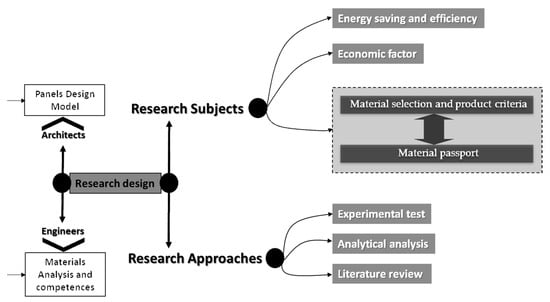
Figure 2.
Procedural workflow and methodological framework.
Through this research, we endeavored to identify and strike a balance between suitable design strategies for bio-green panels, ultimately identifying distinctive features in the built environment. The product comprises two essential bio-based components, an ecological growing medium and a green volume, to achieve a truly ecologically conscious design with zero environmental impact. The system is designed to integrate with the architectural design of the buildings seamlessly, and employs recycled materials such as wood and other bio-sources as growth substrates. An environmental analysis, including an assessment of the environmental profile of each recycled wood substance and the energy performance implications of the component, will be conducted []. The primary focus of this study is to calculate energy-saving performances and environmental impacts for each selected plant, which will be evaluated through experimental testing conducted in various local microclimates, considering plant taxonomy. The plants and vegetation will be categorized based on the plants’ roots, leaves (texture, shape, and size), and colors. The components must be meticulously analyzed and designed to adapt to the buildings’ architectural styles, macroclimates, and microclimates [,]. The experimental testing will be conducted under extreme climate conditions, specifically in summer, to simulate the harsh climate of the Scandinavian region according to the taxonomy and classifications of the plants and different forms of recycled soil materials. The bio-green panel system is crucial in designing bio-economic buildings that align perfectly with the United Nations’ 2030 Sustainable Development Goals (SDGs) and the European Union’s three critical targets for climate and energy by 2030. The product aims to effectively mitigate the adverse impacts of climate change, promoting a healthier and more comfortable living environment both physically and psychologically. Energy efficiency and the environmental implications represent research gaps that this study aims to address. De la Cruz-Lovera et al. emphasize the significant global challenge of and international responsibility to achieve substantial improvements in energy consumption reduction from a demand-side perspective, stressing the immense potential for improvement in this field []. By integrating biologically derived materials into the current system of conventional construction models and embracing sustainability and bioeconomic principles, this research aims to facilitate the transformative evolution of the future generation of the building industry. The study seeks to overcome barriers such as inadequate adoption of new technologies, outdated standards, excessive administrative obstacles, and unsustainable construction practices. Establishing a unified information system for the green construction component will facilitate this process, enabling the creation of an effective product. In this research domain, it is crucial to elucidate how technological and biological fields can incorporate environmental sustainability as a fundamental cornerstone of their products, embrace ecological sustainability in their core principles, and promote changes that minimize the environmental impact on our community [].
3.1. Material Selection and Product Criteria
The selection of construction materials is complex due to their multifaceted purposes, necessitating a logical approach to achieve optimal performance while minimizing environmental impact. It has been recognized that materials or products can serve purposes beyond their primary function, exemplified by the circularity of building materials. Consequently, robust and dependable ranking methods based on multi-criteria analysis are indispensable for maximizing the efficient utilization of materials. Such practices facilitate the identification of materials that enhance a building’s performance and contribute positively to the environment and the well-being of occupants []. Furthermore, this article also focuses on the recycling of bio-based materials and the exploration of the bioeconomy. It involves assessing the environmental friendliness of materials and distinguishing between those that are genuinely environmentally sustainable and those that may only appear to be so due to their biomaterial composition. To establish an effective control mechanism for the quality, recycling, execution, and production process of bio-based panel materials, which essentially entails the virtual creation of the product, the production process must collect data from the natural environment. This data represents, validates, and simulates the physical counterpart’s present and future behavior.
3.1.1. Material Passport and Materials Selection
Utilizing a material passport is imperative for analyzing the environmental efficiency of carefully selected building materials. The effective reuse of materials is essential to minimize environmental impact, primarily by reducing energy consumption and carbon emissions. Furthermore, in alignment with Sustainable Development Goals (SDGs) 7, 11, 12, and 13, structures should be perceived as reservoirs of resources for future utilization (see Figure 3). The material passport tool evaluates the environmental impact of construction materials and assesses their potential for recycling, particularly during the end-of-life stage. This tool undergoes rigorous testing, including a demolition item use case, to determine its applicability and effectiveness in order to assess the recyclability of materials within a building [].

Figure 3.
Materials, evaluations, and selection process.
3.1.2. The Model Design and Execution Process
Close collaboration between architects and engineers is crucial throughout the entire process, from the conception of an idea to the simulation and realization of a product. Initially, architects are responsible for selecting bio-green products, determining suitable colors and textures, and addressing environmental requirements, among other considerations. In the context of future biophilic buildings, bio-green panels have been developed with the capability to store sunlight through the presence of grass blossoms. Therefore, positioning the flower heads of these panels to maximize exposure to sunlight, especially against dark backgrounds, becomes essential. Once the architect’s selection and design phase are complete, construction commences. The designer then establishes specific criteria for the bio-green panels, encompassing factors such as environmental color, textures, and guidelines about their form []. This comprehensive approach will be examined from three distinct perspectives:
- An integrated design methodology developed by architects and building designers at the macro-design level employs a deliberate configuration of distinct modules encompassing elements such as form, size, plant texture, colors, and other relevant factors.
- The micro-design phase of the process encompasses the Specific Panel Design Model, which entails the deliberate selection and integration of components, materials, and plant types.
- Databases emerge from evaluations and analyses conducted on diverse materials, plants, and growing medium variables, focusing on assessing their environmental impacts, energy efficiency, and economic viability.
3.1.3. The Panel’s Application
The architect and designers believe that the product will be viable for the building component, who will submit criteria to the AEC industries to manufacture customized panels based on the plant’s environmental, energy, and economic benefits for a local micro-climate and roofing. Plant-dominated surroundings are more straightforward and less exciting, thus lowering stress. Humans need green spaces. In the future, connections in synchronic, syncretic, and diachronic modes will be established to accommodate human aspirations and needs within the natural world. Ideas for a living harbor with a high sensory value that can define a healthy structure by using metaphors for twinning with nature to improve life quality will also be applied [,]. Architecture also needs greenery. An architectural feature can combine soil or other growth media to grow plants or flora, water to nurture them, and fauna drawn in by nourishment []. Future structures look best with bio-basis elements. Loving nature is loving its system. Thus, biophilic architecture begins with a novel architectural idea based on ecological integrative balancing workshops that address structures, configurations, functions, and the teaching process.
3.2. Custom Growth Medium Based on Thermal, Economic, and Efficiency Factors
The growth and development of plants are intricately linked to the quality of the soil they inhabit. Inadequate growth can often be attributed to the presence of substandard soil conditions. Given the diverse soil types, selecting and implementing suitable soil becomes complex when designing and constructing green buildings. Thus, carefully considering the specific soil requirements for each plant species is imperative. Temperature fluctuations exert a significant influence on soil properties, thereby impacting various thermophysical characteristics. Among these characteristics, the thermal properties of clay soil play a crucial role in governing energy and mass transfer mechanisms. Understanding the natural processes underlying soil formation and evaluating soil suitability as a growth medium for plants on green roofs and walls necessitate a comprehensive understanding of thermophysical properties.
In this context, knowledge regarding thermophysical properties becomes indispensable. Such properties include the average density of clay soil, typically 1600 kg/m3, and a corresponding thermal conductivity value of 1.28 W/m·K [].
The process of selecting the growing medium hinges upon using recycling and bio-source materials, as underscored by the literature []. This emphasis on recycling and bio-sourced materials aligns with the overarching objective of transitioning to a circular economy and achieving closure of the product life cycle. At the European level, the European Commission (EC) has identified critical raw resources, construction, demolition, and bio-based materials as five priority sectors for realizing this vision (EC, 2015). The EC has set ambitious targets to recycle 70% of all building and demolition waste and 65% of all municipal solid waste (MSW) by 2030 [].
Using recycled organic materials in growing media is a favorable alternative, facilitating optimal plant development. Conversely, for the growing chamber, horticultural rock wool and recycled wood stand out as desirable choices due to their high absorbency and porosity. Moreover, regarding bio-green panels, recycled materials exhibit superior characteristics, making them the most suitable growth medium. As illustrated in Figure 4, the experimental setup will incorporate six types of bio-based growth media that can be derived from recycled resources.
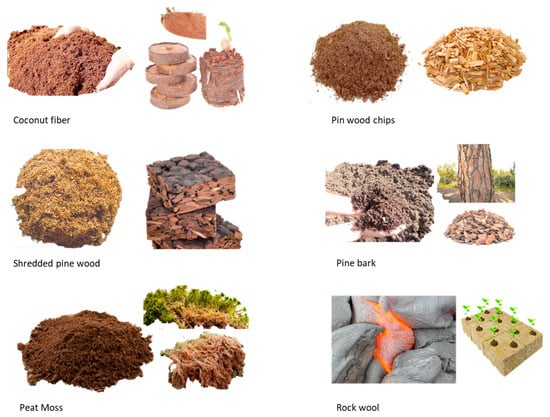
Figure 4.
Different types of innovative growing medium.
- Coconut fiber;
- Pine wood chips;
- Shredded pine wood;
- Pine bark;
- Peat moss;
- Rock wool.
Coconut fiber, derived from the natural cellulose fiber found in coconut husks, offers an environmentally acceptable alternative for various applications. Positioned between a coconut’s outer and intricate interior shells, this fibrous material exhibits desirable properties as a textile substitute, making it an attractive choice with a renewable and natural origin. In building insulation, exploring the potential utilization of biodegradable coconut fibers as a thermally insulating material becomes crucial []. The thermal conductivity of coconut fiber varies across different densities. For instance, at a 120 kg/m3 density, the thermal conductivity is recorded as 0.05 W/m·K [,]. Although coconut fiber lacks the nutrient content of organic soil, it acts as a soil conditioner by creating air pockets that facilitate efficient drainage and root growth [].
Being organic, pine wood chips gradually decompose and enrich the soil with nutrients over time. These wood chips serve the dual purpose of protecting plant roots and enhancing soil fertility. Furthermore, the thermal conductivity of pine wood chips, denoted as “k,” is measured at 0.1213 W/m·K, with variations observed at different moisture contents. When dry, these wood chips exhibit a density of 380 kg/m3 [].
Shredded pine wood, called wood chips, encompasses shredded wood particles, including leaves, branches, and bark. The application of wood particles as mulch is known as wood mulch. Despite potential misconceptions surrounding shredded pine wood, pine needles, and pine chip mulch, they offer several advantages when employed as soil components in BIO-GREEN PANELS. Notably, a significant positive correlation (coefficient of determination = 0.82) exists between thermal conductivity and panel density, with the denser boards (480 kg/m3) exhibiting a thermal conductivity of 0.093 W/(m·K) [].
Pine bark can be an effective soil conditioner, often derived from wood milling waste materials. The finely crushed form of pine bark enhances the soil’s “pore space,” facilitating the passage of nutrients and oxygen while aiding in moisture retention []. Additionally, pine bark soil conditioner enriches the soil with various nutrients, including nitrogen, potassium, phosphorus, iron, magnesium, and other minerals []. Waste generated by the forestry and forest products sector, such as pine bark and pinecones, poses significant challenges for the logging, lumbering, and construction industries. The density of pine bark is approximately 333 kg/m3 []. With a thermal conductivity of 0.128 W/m·K, Calabrian pine bark demonstrates excellent thermal insulation properties when used in composites [].
Peat moss plays a crucial role in water management and prevents nutrient leaching. Moreover, it improves soil texture and stability []. Moss mats exhibit promising characteristics as cavity insulation materials. Notably, moss panels and carpets exhibit the lowest thermal conductivity, measuring 0.04 W/m·K at a 50 kg/m3 density. These results indicate that peat moss contributes to the production of insulation panels, owing to its comparable mechanical stability and thermal conductivity to other insulation materials [].
Rock wool, composed of fibrous sand and rock, can be shaped into slabs and blocks to promote plant growth. It can also be used as a loose material to fill pots []. Rock wool’s exceptional thermal insulation performance is a defining feature of its suitability for construction applications with low energy requirements. Despite the relatively low thermal conductivity of 0.044 W/(m·K) for a density of 10 kg/m3, which is comparatively low among inorganic thermal insulation materials, rock wool exhibits superior sound insulation and absorption capabilities due to its porous nature, effectively impeding the transmission of sound waves []. (Refer to Figure 5 for visual representation).
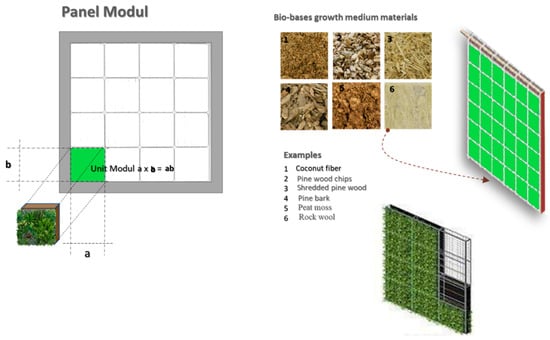
Figure 5.
Growth media within the panel model system.
3.3. Plant Selection Process
According to Xianliang Zhang, the categorization of climatic vegetation provides insight into the climatic characteristics of regional vegetation, with each category exhibiting distinct climatic and vegetative traits []. It is possible to differentiate between regions, such as tropical and temperate deserts, based on equal normalized difference vegetation index (NDVI) values and differing climate conditions. The selection of plant layers is contingent upon factors such as climate zone, location (indoor or outdoor), the thickness of the growing medium, and architectural design. Plants that do not have specific climatic preferences are widely employed in bio-green panels. However, in regions with harsh winters, it is advisable to choose frost-resistant plants [].
While green elements are often depicted as lush vertical oases, many installation attempts fail due to the inadequate consideration of suitable green locations. Therefore, carefully selecting plant species that can thrive in specific climate zones, such as Basrah City, is crucial. This ensures the robustness of the exterior living walls and fences, which should exhibit a diverse range of forms, surfaces, and designs in light and dark green hues. To facilitate calculations, the area of each wall is determined independently by multiplying its width by its height and then adding it to others at the same elevation. The design concept employed in the development of bio-based panels is modular living panels, which incorporate various plant species, including fruits, vegetables, and herbs. These plants contribute to creating a captivating and functional modular living panel. The calculations for green coverage primarily consider the outer building façades and fence walls due to the presence of multiple façades of varying heights on each elevation [].
The experiment was conducted in an open field within a specific climatic location in Basra, Iraq, characterized by exceptionally high temperatures. Expanded polystyrene (EPS), a white foam material composed of solid polystyrene particles, was utilized to construct six container units. EPS is an excellent thermal insulation material for the sides and bottoms of the containers. At the same time, the top section must accommodate the growing medium and selected plants, as depicted in Figure 6. Measurements of the interior spaces of the testing areas will be taken separately, along with the recording of soil temperature and terminal bud temperature during specific intervals.
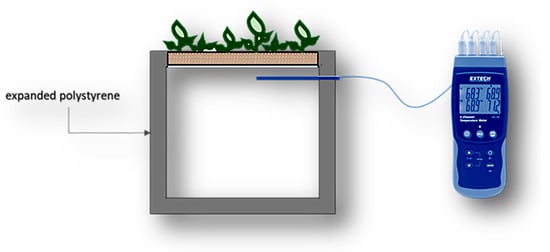
Figure 6.
The experiment test for a prototype module.
The experimental testing models were designed in cubic shapes to enhance their compactness and ensure precise reflection of the obtained results. Each unit possessed the following dimensions: a length of 42 cm, a breadth of 33 cm, and a height of 37 cm. The thicknesses of all these measurements, denoted as x, y, and z, were standardized at 30 mm, although this can be adjusted per the study’s specific requirements. Six plant types deemed suitable for the product’s intended purpose were used to conduct the experimental tests. These plant types are designated following Figure 7.
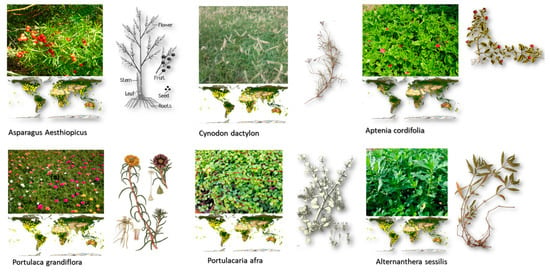
Figure 7.
Selected plants for the experiment test.
3.3.1. Alternanthera sessilis
Alternanthera sessilis, a medicinal plant belonging to the Amaranthaceous family, has been notably employed in Ayurveda. It possesses anti-inflammatory, analgesic, antioxidant, and antibacterial properties. The plant has a growth potential of up to 50 cm, characterized by tiny, lance-shaped dark green leaves with reddish-purple undersides. Delicate white or pink blooms can be observed at the tips of the stems. It thrives in sandy and clay-like soil, as well as in ponds and marshes. Alternanthera sessilis requires full sun or partial shade and exhibits resilience to varying temperatures. The leaves, stems, and roots of Alternanthera sessilis hold medicinal value, relieving fever, diarrhea, dysentery, coughs, and colds [].
3.3.2. Cynodon dactylon
Cynodon dactylon, a perennial herbaceous plant species, is classified within the Cereals’ Svinora genus (Poaceae) and possesses various morphological characteristics. It exhibits elongated subterranean branches that readily establish roots. The stems of this plant are branched, displaying both generative (bearing leaves) and vegetative (green) features. Indigenous to Australia, Asia, southern Europe, and northern Africa, Cynodon dactylon thrives in diverse soil types, encompassing sandy and clay soils. The root sizes of this species vary between 0.1 and 1.9 mm. It is characterized by its perennial nature and grass-like growth, attaining heights ranging from 5 to 45 cm. Additionally, Cynodon dactylon demonstrates a fibrous root system, indicative of its root habit [,].
3.3.3. Portulacaria afra
Portulacaria afra, commonly known as the elephant bush or spekboom, is a small-leaved succulent native to South Africa. It thrives in well-drained, light, sandy to stony soil with a pH of 5.5 to 7.5. This drought-tolerant plant prefers abundant sunlight and is popular in gardens for its tree-like form and succulent leaves. It suits sunny borders, rock gardens, rooftop gardens, and decorative planters. It should be brought indoors or placed into a glass greenhouse when temperatures are below 10 degrees Celsius [].
3.3.4. Asparagus aesthiopicus
Asparagus aethiopicus is a perennial climber with solid, woody stems and small recurved spines. It features leaf-like cladodes and grey-green, thin, feathery leaves. The plant produces white or pink flowers that transform into small red berries. Apart from its decorative qualities, it has a history of therapeutic use, including for treating coughs, fevers, and menstrual cramps [].
3.3.5. Aptenia cordifolia
Aptenia cordifolia is a perennial evergreen succulent that attains a height of approximately 250 mm. It displays a vigorous growth habit and possesses thick, fleshy roots. The succulent stems of this plant measure approximately 600 mm in length and exhibit a spherical or four-angled morphology, sprawling flat on the ground. Notably, the stem surfaces are densely populated with water or bladder cells, which serve as radiating layers under solar exposure. The leaves of Aptenia cordifolia are broad and flat, ranging in shape from heart-shaped to oval, with dimensions of approximately 60 × 25 mm. They are arranged singly or in pairs and are widely spaced. The leaf surface is characterized by water cells [].
3.3.6. Portulaca grandiflora
The flowers of this plant exhibit a range of colors, including red, orange, pink, white, and yellow, with diameters measuring 2.5–3 cm. The upright stems branch near the trunk and the spreading leaves are 20–25 mm long and 2–3 mm wide, tapering towards the tip. The flowers, varying in color from deep purple to bright crimson, can be small (15 mm diameter) or relatively large (up to 30 mm wide). Terminal blooms are commonly found at the branch forks. Flowering occurs from early spring to late summer, with peak blooming during midday and early afternoon [].
As depicted in Figure 8, the experimental configuration was implemented in an outdoor setting, selected for its practicality and logistical feasibility. This approach allowed for the careful placement of each plant within an environment that best aligned with its specific climatic demands.
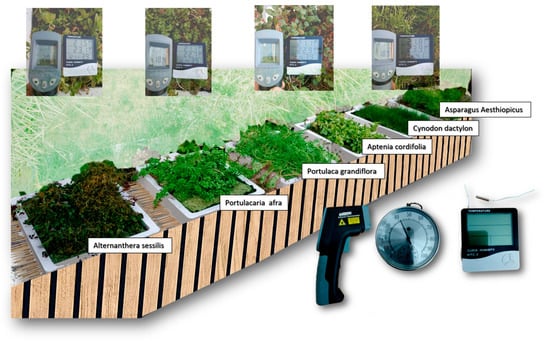
Figure 8.
Testing place in addition to the measuring devices (Brüder Mannesmann, M99991 Infrared Thermometer, Germany) utilized during testing.
4. Results
The main objectives of this study encompass the evaluation and classification of the green components, specifically vegetation, and plants, incorporated within the product, focusing on their energy performance. The article proficiently categorizes plants using comprehensive analyses and taxonomies based on their energy-saving capabilities. Furthermore, a real-world experiment emphasizing thermal insulation performance was conducted to establish a precise taxonomy of plant energy suitable for integration into bio-green panels within sustainable building systems. The outcomes of these analyses and taxonomies significantly contribute to advancing knowledge in this domain.
4.1. Material Passport and Material Selection Process
Utilizing the material passport and the material selection process is essential in dealing with the intricate nature of material decisions in the construction sector. The material selection process is pivotal for attaining optimum performance while mitigating environmental repercussions. It entails the adoption of systematic methodologies and robust evaluation techniques rooted in multi-criteria analysis. The ultimate objective is to identify materials that enhance building performance and have positively contributed to the preservation of the mental health and well-being of occupants. Moreover, the material selection process involves the assessment of bio-based materials and their eco-friendliness, differentiating between genuinely sustainable alternatives and those that might only appear as such due to their biomaterial composition (see Figure 9).
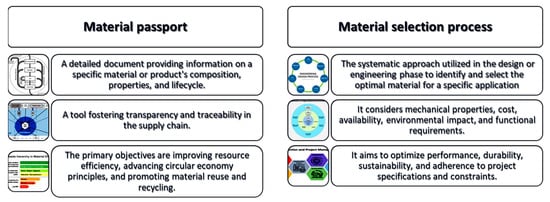
Figure 9.
A comparative analysis of the material passport and the material selection process.
4.2. Enhancing Growth Medium Efficiency and Sustainability
4.2.1. Economic Factor
The escalating costs of construction materials have become a persistent concern for developers. The recent Ukrainian crisis has immediately impacted the prices of building materials, even from the onset of this year. This crisis has directly influenced the global market for constructing and finishing products. Similarly to the trends observed in 2021, prices for building supplies have surged by 30–50% or possibly even more due to the robust performance of the US dollar and the potential scarcity of materials []. Consequently, this disparity in pricing across various materials has manifested in the pricing of bio-panel soil materials, as depicted in Figure 10. However, we must select a combination of materials that are not only cost-effective but also environmentally beneficial. Based on the research findings, it can be deduced that rock wool offers the most compelling economic advantages in terms of energy conservation, surpassing both pinewood chips and pine bark in this regard.
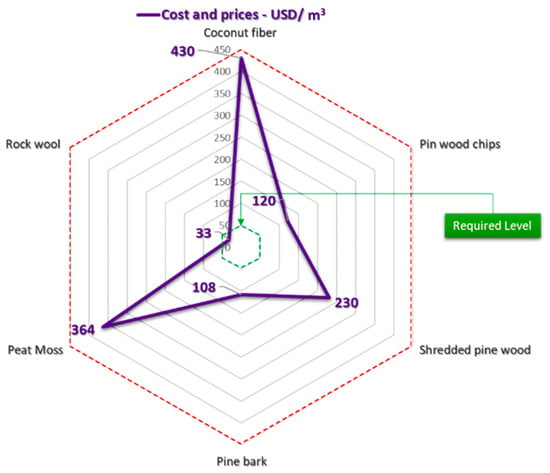
Figure 10.
Economic factors in selecting a growth medium (based on [,]).
4.2.2. Material Selection and Efficiency
Soil material selection plays a crucial role in construction projects as it directly impacts the success and efficiency of the project. Location, climate, and intended usage must be carefully considered when choosing the appropriate soil type. Different soil types are more suitable for specific purposes, such as planting or building foundations. The composition of the soil is significant, as it comprises various chemicals []. The proportions of different particle types of influence soil texture, drainage capability, and nutrient-holding capacity. The selection of a soil material also entails evaluating its efficiency in meeting the project’s requirements, as depicted in Figure 11. The findings reveal that rockwool demonstrates the highest efficiency level, while peat moss and coconut fiber offer comparable advantages in terms of material characteristics.
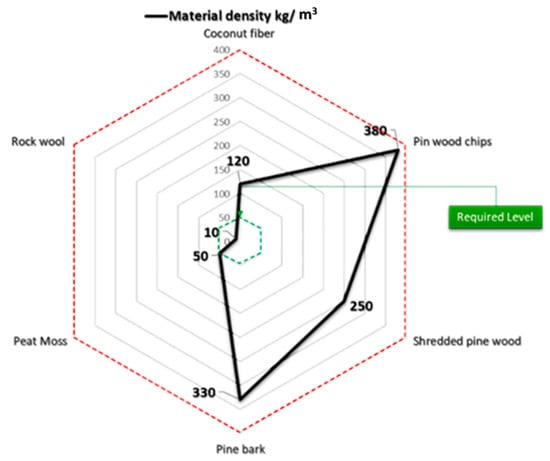
Figure 11.
Material factors in the selection of a growth medium.
4.2.3. The Thermal Insulation and Efficiency
Soil is an effective insulating medium for buildings, contributing to energy conservation. Using a growth medium can further enhance this insulation effect, reducing heat ingress during hot weather and lowering the demand for air conditioning []. Additionally, the growth medium has the potential to enhance building energy efficiency beyond thermal insulation alone. Figure 12 compares various growth mediums’ thermal conductivity (w/mk) values.
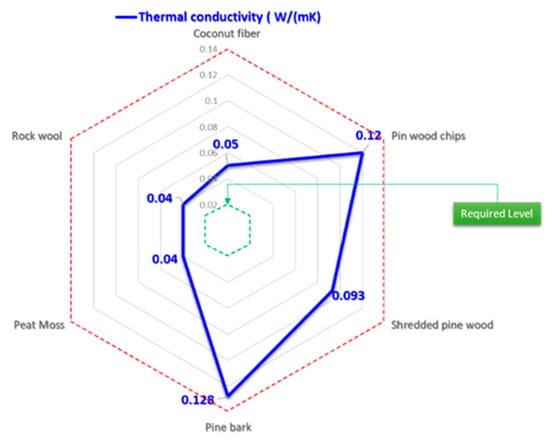
Figure 12.
Thermal insulation factor in the selection of a growth medium.
Rockwool has gained widespread recognition as an approved thermal insulation material, supported by the article’s findings emphasizing its exceptional energy efficiency. Likewise, peat moss and coconut fiber demonstrate commendable levels of energy efficiency, establishing them as equally effective materials in this context.
Basrah experiences a wide temperature range, reaching a peak of 48 °C in July and September while plummeting below freezing in January. Most of the annual rainfall, i.e., approximately 90%, occurs from December to March—conversely, dry weather and average temperatures of around 32 °C characterize June, July, and August. Despite the relatively higher relative humidity in the Arabian Gulf region, the climate of Basrah remains minimally impacted. Summer evenings are straightforward, while roughly one-third of winter evenings are clouded []. Three distinct testing periods in September (the 20th, 21st, and 29th) were selected to enhance the reliability of the results, as depicted in Figure 13.
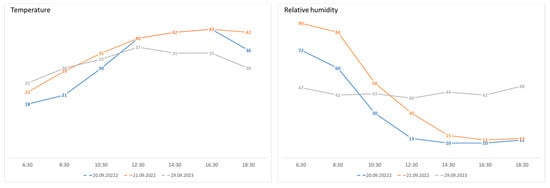
Figure 13.
Weather measurements were conducted in Basrah City at the designated testing site.
4.3. Exploring the Experimental Data
The experimental results were analyzed in order to examine each selected plant’s disparities in temperature and relative humidity between the interior room and the external environment. Furthermore, the temperatures of the plant leaves were measured to gain a deeper understanding of the plant’s response to its surrounding temperature.
4.4. Indoor Marginal Temperature
The results show that each plant species possesses a unique capacity to serve as a heat insulator. The study examined the thermal efficiency of selecting plants from Basra for utilization in BIO-GREEN PANELS, resulting in distinct differences in indoor marginal temperatures. The trial outcomes are presented in Figure 14, which illustrates the fluctuations observed during the energy-saving process. The collected data indicate significant variations in temperature shifts when specific plant species were employed compared to others. Notably, these effects were most pronounced in exceptionally high temperature conditions, particularly on 21 and 22 September between 12:30 and 14:30. Minor changes were also observable at other times, such as after 16:30 on 29 September and throughout the morning session. A comprehensive investigation confirmed the prominent influence of plant selection on thermal regulation within the studied context.
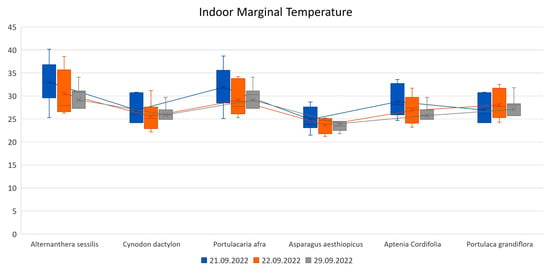
Figure 14.
The indoor marginal temperature at different measurement times and dates for other selected plants.
Based on the data presented in Table 2, the experimental results further substantiate the notion that including vegetation plays a pivotal role in energy conservation, offering a significant advantage for energy-saving strategies. The execution of the experiment itself supports this assertion. Each distinct plant selection yields a unique set of consequences, systematically compared in Table 2. The findings indicate that the utilization of “Asparagus Aethiopicus” and “Cynodon dactylion” led to favorable effects. Conversely, the implementation of “Alternanthera sessile” and “Portulacaria afra” resulted in outcomes that could be more desirable.

Table 2.
The divergences in energy conservation achieved through the implementation of various selected plant species (with “A” denoting an advantageous outcome and “+” representing the corresponding magnitude of energy savings).
The quantification of the energy-saving capacity can be observed in the thermal gradient displayed by specific plant species within their external and internal environments. A substantial temperature differential signifies an enhanced propensity for conserving energy, especially when temperatures are heightened throughout the day. Conversely, a diminished temperature differential indicates a lower efficacy in energy preservation. The energy-saving attributes associated with the diverse plant species utilized in BIO-GREEN PANELS are graphically presented in Figure 15.
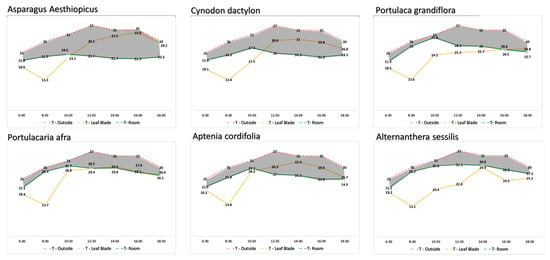
Figure 15.
The marginal temperatures of indoor spaces according to the different selected plants.
5. Discussion
Bio-based materials represent a unique category of renewable building materials and are known for their inherent flexibility and versatility. In contrast to comparable products and structures from alternative materials, utilizing wood products entails notably lower energy consumption. Additionally, wood is widely recognized as one of the most environmentally friendly building materials, especially compared to non-renewable materials derived from fossilized organic matter. Adhikari et al. posited that an enhanced understanding of environmental and climate considerations, coupled with evolving consumption patterns, would establish fresh prospects for the forestry sector and wood construction to devise pragmatic and sustainable green solutions that align with customer preferences []. Eleonor C. and colleagues believe that bio-based recycled materials should be investigated for their insulation properties to support future research on eco-efficient products. Innovative bio-based products use renewable biological raw materials []. To comprehend the responses of plants to environmental stimuli, it is crucial to incorporate the specific meteorological conditions prevailing at the study location. Basra, renowned for its extreme temperatures, undergoes scorching periods between July and September, with temperatures soaring to 48 degrees Celsius. Conversely, the coldest month, January, experiences freezing temperatures. Hence, the present study considered the unique climatic conditions of Basra City. The research involved the collection of measurements to investigate temperature and relative humidity variations between indoor rooms and outdoor environments, while testing various plant species. To ensure the reliability of the findings, three distinct testing periods were selected within September. The primary focus of the analysis was centered on the indoor marginal temperature, as it provided valuable insights into the heat insulation capabilities exhibited by each plant species. The introduction of the innovative product, BIO-GREEN PANELS, is expected to stimulate growth in the architecture, engineering, and construction (AEC) industry, particularly in utilizing renewable and sustainable building materials. These panels offer a high degree of flexibility in material selection. They are equipped with multi-use components, thus facilitating energy-saving practices, efficient recycling concepts, and the development of renewable energy sources based on biomass. Furthermore, they contribute to the greening of the industrial sector and promote improved environmental sustainability. The concept of the bioeconomy, which entails replenishing natural resources to generate products, services, energy, and materials, is set to take a prominent role in the coming years. In regions characterized by scorching temperatures, such as Basra, it is paramount to consider heat gains originating from domestic sources and solar radiation. This consideration becomes especially urgent in situations requiring the heating or cooling of supply air, necessitating a careful assessment of the available heat carriers []. Furthermore, engineering systems should be capable of calculating their energy consumption using a non-stationary thermal regime, considering the daily fluctuations in ambient temperature and solar radiation [,]. By doing so, it becomes possible to harness the advantageous attributes of green elements with high thermal inertia.
The examination of the collected data revealed substantial temperature variations based on the employed plant species. Notably, the most pronounced impacts were observed at exceptionally high temperatures, specifically between 12:30 and 14:30 on 21 and 22 September. Additionally, more minor temperature alterations were observed on other occasions, such as 29 September after 16:30 and throughout the morning session. Furthermore, Table 2 presents the differences in energy conservation achieved by utilizing various plant species. The temperature of the leaves was also examined during the experiment. The outcomes demonstrate that incorporating plants into bio-green panels significantly contributes to energy conservation. This finding is particularly significant for energy-saving strategies, as the experiment effectively demonstrates the benefits of such practices.
However, it is worth noting that the effects attributed to “Alternanthera sessile” and “Portulacaria afraid” could have been more favorable. The ability of certain plant species to maintain temperature differences between their exterior and interior habitats indicates their capacity for energy saving. A more significant temperature difference shows a higher potential for energy conservation, especially at peak daytime temperatures. Conversely, a lower temperature difference suggests reduced energy-saving potential. These results provide valuable insights for selecting plant species to develop bio-green panels for sustainable building systems. In addition, they hold substantial implications for architecture, engineering, and construction (AEC) professionals, particularly those engaged in energy-efficient design and construction. By incorporating the knowledge from this research, engineers, and architects can create bio-based products and materials suitable for interior and exterior applications. Installing energy-efficient bio-green panels in buildings enhances energy efficiency, addressing the growing demand for environmentally responsible and sustainable construction practices. This research categorized and analyzed the green components utilized in bio-green panels based on their energy performance to a satisfactory extent. In addition, through analysis and taxonomies of the plants, the researchers identified species that exhibit significant energy-saving capacities. The experiment’s findings highlight the importance of selecting appropriate plant species to maximize energy savings, as different plants yield varying temperature differences. Furthermore, these recent advancements in our understanding of plant energy utilization will facilitate the development of bio-based products and materials suitable for sustainable building systems. Consequently, this will promote the design of energy-efficient buildings, aligning with the goal of reduced energy consumption.
This study recreated the site’s outdoor vertical flora before development to assess the high energy prices and energy usage. However, this would enhance air quality, cut carbon footprints, and affect the local microclimate []. Thermal façade renovations must improve energy efficiency. New grading techniques for sustainability of the living environment are being developed in order to achieve better building consumer attributes. Instead of expanding the insulation layer, S. V. Korniyenko and colleagues suggest improving the façade’s design to achieve an inexpensive and practical heat-insulating effect []. Classifying plants and collecting “green” building taxonomy data can help urban planners and architects to improve building energy efficiency and environmental safety. Bio-based green panels and living walls are exceptional indoor and urban hanging gardens. They can soften the image of massive concrete blocks, improve user usage and productivity, and draw pedestrians’ attention [,]. Zimmermann and colleagues suggest synchronizing LCA assessment with bio-based panel production technology in architecture, engineering, and construction (AEC). Through the new product quality factor, these can monitor performance, identify issues, simulate design without building, and provide full access to a machine or structure []. Bio-green panels will represent dynamic digital duplicates of systems, processes, and products linked with architectural solutions. Drawing upon biophilia, individuals prefer natural environments abundant in greenery instead of urban settings lacking botanical elements []. The benefits derived from green spaces extend beyond physiological advantages to encompass evident psychological benefits associated with working outdoors in sunlight and fresh air []. Therefore, it is imperative in the present era to comprehend and investigate the pivotal role of vegetative coverings in the context of buildings []. These coverings function as barriers, impeding the transfer of energy between the interior and exterior of the structure while simultaneously conserving energy and serving as insulation. The integration of green spaces enhances the thermal performance of the building system, curbing heat transmission between the edifice and its surroundings. Moreover, green building coverings that adhere to prescribed property values are equipped with additional thermal insulation attributes. Milad M. reveals that the installation of green panels on rooftops leads to an annual decrease in energy demand by 66%, as well as a daily reduction of 83–85% during spring and summer and 40–44% during fall and winter, attributable to the mitigated heat transfer through the roof []. Furthermore, Li WC and colleagues assert that using a green roof, as opposed to a white roof, can yield energy savings ranging from 40% to 110% []. The emergence of BIO-BASED GREEN PANELS constitutes an up-and-coming innovation within sustainable architecture and environmental stewardship. These panels possess the capacity to transform the integration of vertical greenery within urban settings significantly. Moreover, they embody a novel generation of sustainable structures, acting as a cornerstone for adopting pioneering design methodologies in densely populated cities, thereby engendering numerous advantages at both the architectural and urban levels. Consequently, the utilization of these panels harbors the considerable potential for propelling the field of architectural urbanism forward and fostering the evolution of cities toward enhanced sustainability.
6. Conclusions
In recent years, the recognition of climate change as a significant global threat has intensified, prompting the need for concerted efforts to mitigate its adverse impacts. Given its substantial environmental footprint, the construction industry is pivotal in addressing this challenge. Consequently, developing environmentally friendly building materials and techniques has emerged as a critical priority within the industry, with bio-green panel systems emerging as a promising solution.
Bio-green panels encompass prefabricated façade systems that integrate vegetation, creating vertical gardens on the exterior of buildings. These panels offer a range of advantages, including improved air quality, reduced energy consumption, and enhanced aesthetic appeal. They also contribute to mitigating the urban heat island phenomenon, which refers to the elevated temperatures experienced in cities compared to surrounding rural areas due to human-generated heat. Moreover, adopting bio-green panels in new and existing buildings can significantly reduce the construction industry’s carbon footprint. Traditional construction materials, such as cement and steel, entail substantial greenhouse gas emissions during manufacturing, contributing to climate change. In contrast, bio-green panels constructed from sustainable and renewable materials like bamboo and recycled plastic can significantly diminish the industry’s carbon footprint while promoting a transition to a low-carbon economy.
The implementation of these panels not only yields environmental benefits, but also positively impacts society and the economy. Research has shown that residing in green buildings enhances productivity, physical and mental well-being, and overall quality of life. Furthermore, the increasing demand for environmentally friendly structures represents new opportunities for the construction sector, leading to job creation and economic growth. Thus, panel systems address the interrelated environmental, social, and economic challenges confronting the building industry. Given the escalating threat of climate change and the urgent need to transition toward a sustainable economy, the creation and widespread implementation of these innovative technologies is crucial. It is incumbent upon the building sector to actively contribute to a more sustainable future by embracing the benefits offered by eco-friendly building materials and methodologies.
Author Contributions
Conceptualization: A.A. (Amjad Almusaed) and A.A. (Asaad Almssad); methodology: A.A. (Amjad Almusaed) and A.A. (Asaad Almssad); software: A.A. (Amjad Almusaed); validation: S.A.-S., A.A. (Asaad Almssad) and I.Y.; formal analysis: A.A. (Amjad Almusaed); investigation: A.A. (Amjad Almusaed) and A.A. (Asaad Almssad); resources: A.A. (Asaad Alasadi); data curation: A.A. (Asaad Alasadi); writing—original draft preparation: A.A. (Amjad Almusaed); writing—review and editing: I.Y.; visualization: A.A. (Amjad Almusaed); supervision: A.A. (Amjad Almusaed); project administration: S.A.-S. All authors have read and agreed to the published version of the manuscript.
Funding
This research received no external funding.
Institutional Review Board Statement
This statement is excluded.
Informed Consent Statement
This statement is excluded, as we did not involve humans.
Data Availability Statement
Not applicable.
Conflicts of Interest
The authors declare no conflict of interest.
References
- Park, B.R.; Chung, M.H. Analysis of the additional energy-saving potential of residential buildings after man-datory zero-energy buildings to achieve carbon neutrality in South Korea. Build. Environ. 2023, 228, 109908. [Google Scholar] [CrossRef]
- Tokbolat, S.; Nazipov, F.; Kim, J.R.; Karaca, F. Evaluation of the Environmental Performance of Residential Building Envelope Components. Energies 2020, 13, 174. [Google Scholar] [CrossRef]
- Ollila, A. Challenging the scientific basis of the Paris climate agreement. Int. J. Clim. Chang. Strat. Manag. 2019, 11, 18–34. [Google Scholar] [CrossRef]
- Zhong, X.; Hu, M.; Deetman, S.; Steubing, B.; Lin, H.X.; Hernandez, G.A.; Harpprecht, C.; Zhang, C.; Tukker, A.; Behrens, P. Global greenhouse gas emissions from residential and commercial building materials and mitigation strategies to 2060. Nat. Commun. 2021, 12, 6126. [Google Scholar] [CrossRef] [PubMed]
- Almssad, A.; Almusaed, A.; Homod, R.Z. Masonry in the Context of Sustainable Buildings: A Review of the Brick Role in Architecture. Sustainability 2022, 14, 14734. [Google Scholar] [CrossRef]
- Almusaed, A.; Yitmen, I.; Almsaad, A.; Akiner, I.; Akiner, M.E. Coherent Investigation on a Smart Kinetic Wooden Façade Based on Material Passport Concepts and Environmental Profile Inquiry. Materials 2021, 14, 3771. [Google Scholar] [CrossRef]
- Nußholz, J.L.; Rasmussen, F.N.; Whalen, K.; Plepys, A. Material reuse in buildings: Implications of a circular business model for sustainable value creation. J. Clean. Prod. 2020, 245, 118546. [Google Scholar] [CrossRef]
- Swaminathan, R.; Parker, R.J.; Jones, C.G.; Allan, R.P.; Quaife, T.; Kelley, D.I.; de Mora, L.; Walton, J. The Physical Climate at Global Warming Thresholds as Seen in the U.K. Earth System Model. J. Clim. 2022, 35, 29–48. [Google Scholar] [CrossRef]
- Nasiri, B.; Piccardo, C.; Hughes, M. Estimating the material stock in wooden residential houses in Finland. Waste Manag. 2021, 135, 318–326. [Google Scholar] [CrossRef]
- EEA. Bio-Waste in Europe—Turning Challenges into Opportunities; Publications Office of the European Union: Luxembourg, 2020. [Google Scholar] [CrossRef]
- Jarre, M.; Petit-Boix, A.; Priefer, C.; Meyer, R.; Leipold, S. Transforming the bio-based sector towards a circular economy—What can we learn from wood cascading? For. Policy Econ. 2020, 110, 101872. [Google Scholar] [CrossRef]
- Almusaed, A. Introduction on Plants and Vegetations. In Biophilic and Bioclimatic Architecture; Springer: London, UK, 2011. [Google Scholar] [CrossRef]
- Almssad, A.; Almusaed, A. Efficient daylighting approach using light-shelve device adequate for habitat program in Aarhus City. Int. J. Smart Grid Clean Energy 2014, 3, 441–453. [Google Scholar] [CrossRef]
- Almusaed, A.; Almssad, A. Urban Social Sustainability—Case Study; Gellerupparken–Denmark. In Sustainability in Urban Planning and Design; IntechOpen: London, UK, 2020. [Google Scholar] [CrossRef]
- Almusaed, A.; Yitmen, I. Architectural Reply for Smart Building Design Concepts Based on Artificial Intelligence Simulation Models and Digital Twins. Sustainability 2023, 15, 4955. [Google Scholar] [CrossRef]
- Pittau, F.; Krause, F.; Lumia, G.; Habert, G. Fast-growing bio-based materials as an opportunity for storing carbon in exterior walls. Build. Environ. 2018, 129, 117–129. [Google Scholar] [CrossRef]
- Lakatos, Á. Novel Thermal Insulation Materials for Buildings. Energies 2022, 15, 6713. [Google Scholar] [CrossRef]
- Norouzi, M.; Chàfer, M.; Cabeza, L.F.; Jiménez, L.; Boer, D. Circular economy in the building and construction sector: A scientific evolution analysis. J. Build. Eng. 2021, 44, 102704. [Google Scholar] [CrossRef]
- Mao, Y.; Qi, J.; He, B.-J. Impact of the heritage building façade in small-scale public spaces on human activity: Based on spatial analysis. Environ. Impact Assess. Rev. 2020, 85, 106457. [Google Scholar] [CrossRef]
- Almssad, A.; Almusaed, A. Environmental reply to vernacular habitat conformation from a vast areas of Scandinavia. Renew. Sustain. Energy Rev. 2015, 48, 825–834. [Google Scholar] [CrossRef]
- Bhandari, M.P. Sustainable Development: Is This Paradigm The Remedy of All Challenges? Does Its Goals Capture The Essence of Real Development and Sustainability? With Reference to Discourses, Creativeness, Boundaries and Institutional Architecture. Socioecon. Chall. 2019, 3, 97–128. [Google Scholar] [CrossRef]
- Almusaed, A.; Almssad, A. Quality Assurance in a Sustainable Architecture Creation Process; Technology Reports of Kansai University: Tokyo, Japan, 2020; Volume 62, p. 13. Available online: https://www.kansaiuniversityreports.com/article/quality-assurance-in-a-sustainable-architecture-creation-process (accessed on 22 April 2023).
- Akram, M.W.; Hasannuzaman, M.; Cuce, E.; Cuce, P.M. Global technological advancement and challenges of glazed window, facade system and vertical greenery-based energy savings in buildings: A comprehensive review. Energy Built Environ. 2023, 4, 206–226. [Google Scholar] [CrossRef]
- Brázdová, A.; Kupka, J. The Objectivization of the Living Green Walls Concept as a Tool for Urban Greening (Case Study: LIKO-S a.s., Slavkov u Brna, Czech Republic). Land 2023, 12, 229. [Google Scholar] [CrossRef]
- Nagdeve, S.S.; Manchanda, S.; Dewan, A. Thermal performance of indirect green façade in composite climate of India. Build. Environ. 2023, 230, 109998. [Google Scholar] [CrossRef]
- Hassoun, A.M.; Felix, M. Effect of green facade on the urban microclimate with different street canyon. Arch. Plan. J. 2023, 29, 1. [Google Scholar] [CrossRef]
- Thomas, G.; Thomas, J.; Mathews, G.M.; Alexander, S.P.; Jose, J. Assessment of the potential of green wall on modification of local urban microclimate in humid tropical climate using ENVI-met model. Ecol. Eng. 2023, 187, 106868. [Google Scholar] [CrossRef]
- Su, Y.; Wang, L.; Feng, W.; Zhou, N.; Wang, L. Analysis of green building performance in cold coastal climates: An in-depth evaluation of green buildings in Dalian, China. Renew. Sustain. Energy Rev. 2021, 146, 111149. [Google Scholar] [CrossRef]
- Convertino, F.; Blanco, I.; Vox, G.; Schettini, E. Natural passive system for reducing winter night-time energy loss in buildings. Sustain. Resilient Infrastruct. 2023, 1–15. [Google Scholar] [CrossRef]
- Zhang, H.; Li, T.-T.; Han, J.-J. Quantifying the relationship between land use features and intra-surface urban heat island effect: Study on downtown Shanghai. Appl. Geogr. 2020, 125, 102305. [Google Scholar] [CrossRef]
- Pragati, S.; Priya, R.S.; Pradeepa, C.; Senthil, R. Simulation of the Energy Performance of a Building with Green Roofs and Green Walls in a Tropical Climate. Sustainability 2023, 15, 2006. [Google Scholar] [CrossRef]
- Kumar, T.S.; Shafi, K.; Thomas, R.J.; Mohammed, J. Experimental evaluation of the thermal performance of coir mat and green facade as wall insulation in a tropical climate. Therm. Sci. Eng. Prog. 2023, 40, 101757. [Google Scholar] [CrossRef]
- Herath, H.; Halwatura, R.; Jayasinghe, G. Evaluation of green infrastructure effects on tropical Sri Lankan urban context as an urban heat island adaptation strategy. Urban For. Urban Green. 2018, 29, 212–222. [Google Scholar] [CrossRef]
- Ávila-Hernández, A.; Simá, E.; Ché-Pan, M. Research and development of green roofs and green walls in Mexico: A review. Sci. Total Environ. 2023, 856, 158978. [Google Scholar] [CrossRef]
- Perini, K.; Ottelé, M.; Fraaij, A.L.A.; Haas, E.M.; Raiteri, R. Vertical greening systems and the effect on airflow and temperature on the building envelope. Build. Environ. 2011, 46, 2287–2294. [Google Scholar] [CrossRef]
- Elnabawi, M.H.; Saber, E. A numerical study of cool and green roof strategies on indoor energy saving and outdoor cooling impact at pedestrian level in a hot arid climate. J. Build. Perform. Simul. 2022, 16, 72–89. [Google Scholar] [CrossRef]
- Almusaed, A.; Almssad, A. (Eds.) Sustainable Buildings—Interaction between a Holistic Conceptual Act and Materials Properties; IntechOpen: London, UK, 2018. [Google Scholar] [CrossRef]
- Almusaed, A.; Alasadi, A.; Almssad, A. A Research on the Biophilic Concept upon School’s Design from Hot Climate: A Case Study from Iraq. Adv. Mater. Sci. Eng. 2022, 2022, 7994999. [Google Scholar] [CrossRef]
- Zhong, W.; Schröder, T.; Bekkering, J. Biophilic design in architecture and its contributions to health, well-being, and sustainability: A critical review. Front. Arch. Res. 2021, 11, 114–141. [Google Scholar] [CrossRef]
- Almusaed, A.; Almssad, A.; Najar, K. An Innovative School Design Based on a Biophilic Approach Using the Appreciative Inquiry Model: Case Study Scandinavia. Adv. Civ. Eng. 2022, 2022, 8545787. [Google Scholar] [CrossRef]
- Fassbender, E.; Ludwig, F.; Hild, A.; Auer, T.; Hemmerle, C. Designing Transformation: Negotiating Solar and Green Strategies for the Sustainable Densification of Urban Neighbourhoods. Sustainability 2022, 14, 3438. [Google Scholar] [CrossRef]
- Almusaed, A.; Almssad, A.; Alasadi, A. Analytical interpretation of energy efficiency concepts in the housing design process from hot climate. J. Build. Eng. 2019, 21, 254–266. [Google Scholar] [CrossRef]
- Almusaed, A.; Yitmen, I.; Almssad, A. Enhancing Smart Home Design with AI Models: A Case Study of Living Spaces Implementation Review. Energies 2023, 16, 2636. [Google Scholar] [CrossRef]
- Vandvik, V.; Halbritter, A.H.; Yang, Y.; He, H.; Zhang, L.; Brummer, A.B.; Klanderud, K.; Maitner, B.S.; Michaletz, S.T.; Sun, X.; et al. Plant traits and vegetation data from climate warming experiments along an 1100 m elevation gradient in Gongga Mountains, China. Sci. Data 2020, 7, 189. [Google Scholar] [CrossRef]
- Homod, R.Z.; Almusaed, A.; Almssad, A.; Jaafar, M.K.; Goodarzi, M.; Sahari, K.S. Effect of different building envelope materials on thermal comfort and air-conditioning energy savings: A case study in Basra city, Iraq. J. Energy Storage 2021, 34, 101975. [Google Scholar] [CrossRef]
- De la Cruz-Lovera, C.; Perea-Moreno, A.-J.; De la Cruz-Fernández, J.-L.; Alvarez-Bermejo, J.A.; Manzano-Agugliaro, F. Worldwide Research on Energy Efficiency and Sustainability in Public Buildings. Sustainability 2017, 9, 1294. [Google Scholar] [CrossRef]
- Watson, R.T.; Boudreau, M.C.; Chen, A.J. Information Systems and Environmentally Sustainable Development: Energy Informatics and New Directions for the IS Community. MIS Q. 2010, 34, 23–38. [Google Scholar] [CrossRef]
- Maskell, D.; Thomson, A.; Walker, P. Multi-criteria selection of building materials. Proc. Inst. Civil Eng.–Constr. Mater. 2018, 171, 49–58. [Google Scholar] [CrossRef]
- Honic, M.; Kovacic, I.; Aschenbrenner, P.; Ragossnig, A. Material Passports for the end-of-life stage of buildings: Challenges and potentials. J. Clean. Prod. 2021, 319, 128702. [Google Scholar] [CrossRef]
- Kim, D.Y. A Design Methodology Using Prototyping Based on the Digital-Physical Models in the Architectural Design Process. Sustainability 2019, 11, 4416. [Google Scholar] [CrossRef]
- Amjad, A.; Almssad, A. Sustainable Wooden Skyscrapers for the Future Cities. In Wood Industry-Past, Present, and Future Outlook; IntechOpen: London, UK, 2022. [Google Scholar] [CrossRef]
- Nikuze, A.; Sliuzas, R.; Flacke, J.; van Maarseveen, M. Livelihood impacts of displacement and resettlement on informal households—A case study from Kigali, Rwanda. Habitat Int. 2019, 86, 38–47. [Google Scholar] [CrossRef]
- Yitmen, I.; Al-Musaed, A.; Yücelgazi, F. ANP model for evaluating the performance of adaptive façade systems in complex commercial buildings. Eng. Constr. Archit. Manag. 2021, 29, 431–455. [Google Scholar] [CrossRef]
- Dong, Y.; McCartney, J.S.; Lu, N. Critical Review of Thermal Conductivity Models for Unsaturated Soils. Geotech. Geol. Eng. 2015, 33, 207–221. [Google Scholar] [CrossRef]
- Atzori, G.; Pane, C.; Zaccardelli, M.; Cacini, S.; Massa, D. The Role of Peat-Free Organic Substrates in the Sustainable Management of Soilless Cultivations. Agronomy 2021, 11, 1236. [Google Scholar] [CrossRef]
- Scialpi, G.; Perrotti, D. The use of urban biowaste and excavated soil in the construction sector: A literature review. Waste Manag. Res. J. Sustain. Circ. Econ. 2021, 40, 262–273. [Google Scholar] [CrossRef]
- Manohar, K.; Ramlakhan, D.; Kochhar, G.; Haldar, S. Biodegradable fibrous thermal insulation. J. Braz. Soc. Mech. Sci. Eng. 2006, 28, 45–47. [Google Scholar] [CrossRef]
- Rodríguez, N.; Yáñez-Limón, M.; Gutiérrez-Miceli, F.; Gomez-Guzman, O.; Matadamas-Ortiz, T.; Lagunez-Rivera, L.; Feijoo, J.V. Assessment of coconut fibre insulation characteristics and its use to modulate temperatures in concrete slabs with the aid of a finite element methodology. Energy Build. 2011, 43, 1264–1272. [Google Scholar] [CrossRef]
- Bui, H.; Sebaibi, N.; Boutouil, M.; Levacher, D. Determination and Review of Physical and Mechanical Properties of Raw and Treated Coconut Fibers for Their Recycling in Construction Materials. Fibers 2020, 8, 37. [Google Scholar] [CrossRef]
- Arachchi, L.P.V.; Somasiri, L.L.W. Use of coir dust on the productivity of coconut on sandy soils. Cocos 2010, 12, 54–71. [Google Scholar] [CrossRef]
- Skogsberg, K.; Lundberg, A. Wood chips as thermal insulation of snow. Cold Reg. Sci. Technol. 2005, 43, 207–218. [Google Scholar] [CrossRef]
- Kain, G.; Marius, C.; Barbu, A.P. Insulation Material Made from Tree Bark. In Proceedings of the Xiv World Forestry Congress, Durban, South Africa, 7–11 September 2015. [Google Scholar]
- Hoskins, T.C.; Owen, J.; Niemiera, A.X. Water Movement through a Pine-bark Substrate during Irrigation. Hortscience 2014, 49, 1432–1436. [Google Scholar] [CrossRef]
- Al-Zawahreh, K.; Barral, M.T.; Al-Degs, Y.; Paradelo, R. Competitive removal of textile dyes from solution by pine bark-compost in batch and fixed bed column experiments. Environ. Technol. Innov. 2022, 27, 102421. [Google Scholar] [CrossRef]
- Petráš, R.; Mecko, J.; Krupová, D.; Slamka, M.; Pažitný, A. Aboveground biomass basic density of softwoods tree species. Wood Res. 2019, 64, 205–212. [Google Scholar]
- Efe, F.T. Investigation of some physical and thermal insulation properties of honeycomb-designed panels produced from Calabrian pine bark and cones. Eur. J. Wood Wood Prod. 2022, 80, 705–718. [Google Scholar] [CrossRef]
- Yli-Halla, M.; Lötjönen, T.; Kekkonen, J.; Virtanen, S.; Marttila, H.; Liimatainen, M.; Saari, M.; Mikkola, J.; Suomela, R.; Joki-Tokola, E. Thickness of peat influences the leaching of substances and greenhouse gas emissions from a cultivated organic soil. Sci. Total Environ. 2022, 806, 150499. [Google Scholar] [CrossRef]
- Kain, G.; Morandini, M.; Stamminger, A.; Granig, T.; Tudor, E.M.; Schnabel, T.; Petutschnigg, A. Production and Physical–Mechanical Characterization of Peat Moss (Sphagnum) Insulation Panels. Materials 2021, 14, 6601. [Google Scholar] [CrossRef]
- Dubsky, M.; Šrámek, F. Crushed rockwool as a component of growing substrates. Acta Hortic. 2008, 779, 491–496. [Google Scholar] [CrossRef]
- Lu, G.; Zheng, X.; Zhang, J. Technical Study on the Rock Wool/Polyurethane Composite Insulation Board and Its External Insulation System for Ultra-low Energy Consumption Buildings. IOP Conf. Ser. Mater. Sci. Eng. 2019, 585, 012074. [Google Scholar] [CrossRef]
- Zhang, X.; Wu, S.; Yan, X.; Chen, Z. A global classification of vegetation based on NDVI, rainfall, and temperature. Int. J. Clim. 2016, 37, 2318–2324. [Google Scholar] [CrossRef]
- Peixoto, M.D.M.; Friesen, P.C.; Sage, R.F. Winter cold-tolerance thresholds in field-grown Miscanthus hybrid rhizomes. J. Exp. Bot. 2015, 66, 4415–4425. [Google Scholar] [CrossRef] [PubMed]
- Yitmen, I.; Almusaed, A.; Alizadehsalehi, S. Investigating the Causal Relationships among Enablers of the Construction 5.0 Paradigm: Integration of Operator 5.0 and Society 5.0 with Human-Centricity, Sustainability, and Resilience. Sustainability 2023, 15, 9105. [Google Scholar] [CrossRef]
- Milech, C.; Amaral, M.N.D.; Auler, P.A.; Lucho, S.R.; Kleinowski, A.M.; da Maia, L.C.; Bianchi, V.J.; Braga, E.J.B. Betalain accumulation and de novo transcriptome sequencing reveal the potential to increase bioactive compounds in Alternanthera sessilis elicited by methyl jasmonate. Acta Physiol. Plant. 2023, 45, 15. [Google Scholar] [CrossRef]
- Chompunut, L.; Wanaporn, T.; Anupong, W.; Narayanan, M.; Alshiekheid, M.; Sabour, A.; Karuppusamy, I.; Chi, N.T.L.; Shanmuganathan, R. Synthesis of copper nanoparticles from the aqueous extract of Cynodon dactylon and evaluation of its antimicrobial and photocatalytic properties. Food Chem. Toxicol. 2022, 166, 113245. [Google Scholar] [CrossRef]
- Licata, M.; Farruggia, D.; Iacuzzi, N.; Leto, C.; Tuttolomondo, T.; Di Miceli, G. Effect of irrigation with treated wastewater on bermudagrass (Cynodon dactylon (L.) Pers.) production and soil characteristics and estimation of plant nutritional input. PLoS ONE 2022, 17, e0271481. [Google Scholar] [CrossRef]
- du Toit, A.; MacDonald, R.; Steyn, E.; Mahlanza, Z.P.; Zulu, A.B.; de Wit, M. Review of the Underutilized Indigenous Portulacaria afra (Spekboom) as a Sustainable Edible Food Source. Agronomy 2023, 13, 1206. [Google Scholar] [CrossRef]
- Awati, S.S.; Gilhotra, R.M.; Singh, S.K.; Raj, V.; Wadkar, K.A. In vitro Antioxidant Potential and Cytotoxicity Study of Asparagus aethiopicus L. Extracts on HT-29 Human Colon Cancer Cell Line. Indian J. Pharm. Educ. Res. 2020, 54, s570–s579. [Google Scholar] [CrossRef]
- Mozafarjalali, M.; Hajiani, M.; Haji, A. Efficiency of Aptenia Cordifolia Mucilage in Removal of Anion Dyes from Aqueous Solution. Int. J. New Chem. 2020, 7, 111–124. [Google Scholar] [CrossRef]
- Budiawan, A.; Purwanto, A.; Puradewa, L.; Cahyani, E.D.; Purwaningsih, C.E. Wound healing activity and flavonoid contents of purslane (Portulaca grandiflora) of various varieties. RSC Adv. 2023, 13, 9871–9877. [Google Scholar] [CrossRef] [PubMed]
- Liu, B.; Li, R.; Wang, J.; Liu, Y.; Li, S. Subassembly Partition of Hull Block Based on Two-Dimensional PSO Algorithm. J. Mar. Sci. Eng. 2023, 11, 1006. [Google Scholar] [CrossRef]
- LaFrance, J.T. Do increased commodity prices lead to more or less soil degradation? Aust. J. Agric. Econ. 1992, 36, 57–82. [Google Scholar] [CrossRef]
- De Graaff, J. The Price of Soil Erosion: An Economic Evaluation of Soil Conservation and Watershed Development; Wageningen University and Research: Wageningen, The Netherlands, 1996. [Google Scholar]
- Zada, U.; Jamal, A.; Iqbal, M.; Eldin, S.M.; Almoshaogeh, M.; Bekkouche, S.R.; Almuaythir, S. Recent advances in expansive soil stabilization using admixtures: Current challenges and opportunities. Case Stud. Constr. Mater. 2023, 18, e01985. [Google Scholar] [CrossRef]
- Jamei, E.; Chau, H.; Seyedmahmoudian, M.; Mekhilef, S.; Hafez, F.S. Green roof and energy—Role of climate and design elements in hot and temperate climates. Heliyon 2023, 9, e15917. [Google Scholar] [CrossRef]
- Almusaed, A.; Almssad, A. Urban biophilic theories upon reconstructions process for Basrah City in Iraq. In Proceedings of the Passive and Low Energy Architecture Conference, PLEA, Ahmedabad, India, 16–18 December 2014. [Google Scholar]
- Adhikari, S.; Ozarska, B. Minimizing environmental impacts of timber products through the production process “From Sawmill to Final Products”. Environ. Syst. Res. 2018, 7, 6. [Google Scholar] [CrossRef]
- Cintura, E.; Nunes, L.; Esteves, B.; Faria, P. Agro-industrial wastes as building insulation materials: A review and challenges for Euro-Mediterranean countries. Ind. Crop. Prod. 2021, 171, 113833. [Google Scholar] [CrossRef]
- Almusaed, A.; Almssad, A. Building materials in eco-energy houses from Iraq and Iran. Case Stud. Constr. Mater. 2015, 2, 42–54. [Google Scholar] [CrossRef]
- Mihai, V.; Rusu, L. An Overview of the Ship Ventilation Systems and Measures to Avoid the Spread of Diseases. Inventions 2021, 6, 55. [Google Scholar] [CrossRef]
- Pearlmutter, D.; Theochari, D.; Nehls, T.; Pinho, P.; Piro, P.; Korolova, A.; Papaefthimiou, S.; Mateo, M.C.G.; Calheiros, C.; Zluwa, I.; et al. Enhancing the circular economy with nature-based solutions in the built urban environment: Green building materials, systems and sites. Blue-Green Syst. 2020, 2, 46–72. [Google Scholar] [CrossRef]
- El Menshawy, A.S.; Mohamed, A.F.; Fathy, N.M. A comparative study on green wall construction systems, case study: South valley campus of AASTMT. Case Stud. Constr. Mater. 2022, 16, e00808. [Google Scholar] [CrossRef]
- Korniyenko, S.V.; Astafurova, T.N.; Kozlova, O.P. IOP Conference Series: Materials Science and Engineering; IOP Publishing: Bristol, UK, 2020; Volume 753, p. 022026. Available online: https://iopscience.iop.org/article/10.1088/1757-899X/1079/2/022050 (accessed on 23 May 2023).
- Spence, C. Senses of place: Architectural design for the multisensory mind. Cogn. Res. Princ. Implic. 2020, 5, 46. [Google Scholar] [CrossRef] [PubMed]
- Almusaed, A. Introductory Chapter: A General Reading Process on Landscape Architecture. In Sustainable Buildings, Chapter 1; Almusaed, A., Almssad, A., Eds.; InTech: Horwich, UK, 2018; Available online: https://www.intechopen.com/chapters/61575 (accessed on 10 April 2023). [CrossRef]
- Zimmermann, R.K.; Bruhn, S.; Birgisdóttir, H. BIM-Based Life Cycle Assessment of Buildings—An Investigation of Industry Practice and Needs. Sustainability 2021, 13, 5455. [Google Scholar] [CrossRef]
- Coutts, C.; Hahn, M. Green Infrastructure, Ecosystem Services, and Human Health. Int. J. Environ. Res. Public Health 2015, 12, 9768–9798. [Google Scholar] [CrossRef]
- Mills, J.; Gaskell, P.; Ingram, J.; Dwyer, J.; Reed, M.; Short, C. Engaging farmers in environmental management through a better understanding of behaviour. Agric. Hum. Values 2017, 34, 283–299. [Google Scholar] [CrossRef]
- Darko, A.; Chan, A.P. Critical analysis of green building research trend in construction journals. Habitat Int. 2016, 57, 53–63. [Google Scholar] [CrossRef]
- Mahmoodzadeh, M.; Gretka, V.; Wong, S.; Froese, T.; Mukhopadhyaya, P. Evaluating Patterns of Building Envelope Air Leakage with Infrared Thermography. Energies 2020, 13, 3545. [Google Scholar] [CrossRef]
- Li, W.; Yeung, K. A comprehensive study of green roof performance from environmental perspective. Int. J. Sustain. Built Environ. 2014, 3, 127–134. [Google Scholar] [CrossRef]
Disclaimer/Publisher’s Note: The statements, opinions and data contained in all publications are solely those of the individual author(s) and contributor(s) and not of MDPI and/or the editor(s). MDPI and/or the editor(s) disclaim responsibility for any injury to people or property resulting from any ideas, methods, instructions or products referred to in the content. |
© 2023 by the authors. Licensee MDPI, Basel, Switzerland. This article is an open access article distributed under the terms and conditions of the Creative Commons Attribution (CC BY) license (https://creativecommons.org/licenses/by/4.0/).